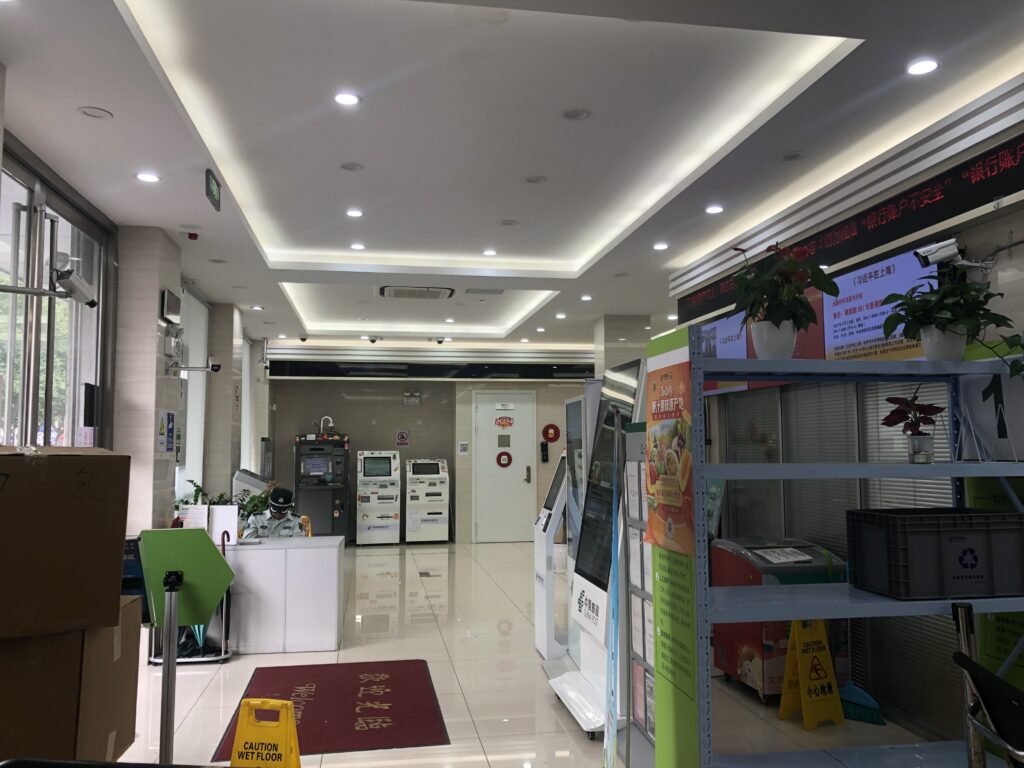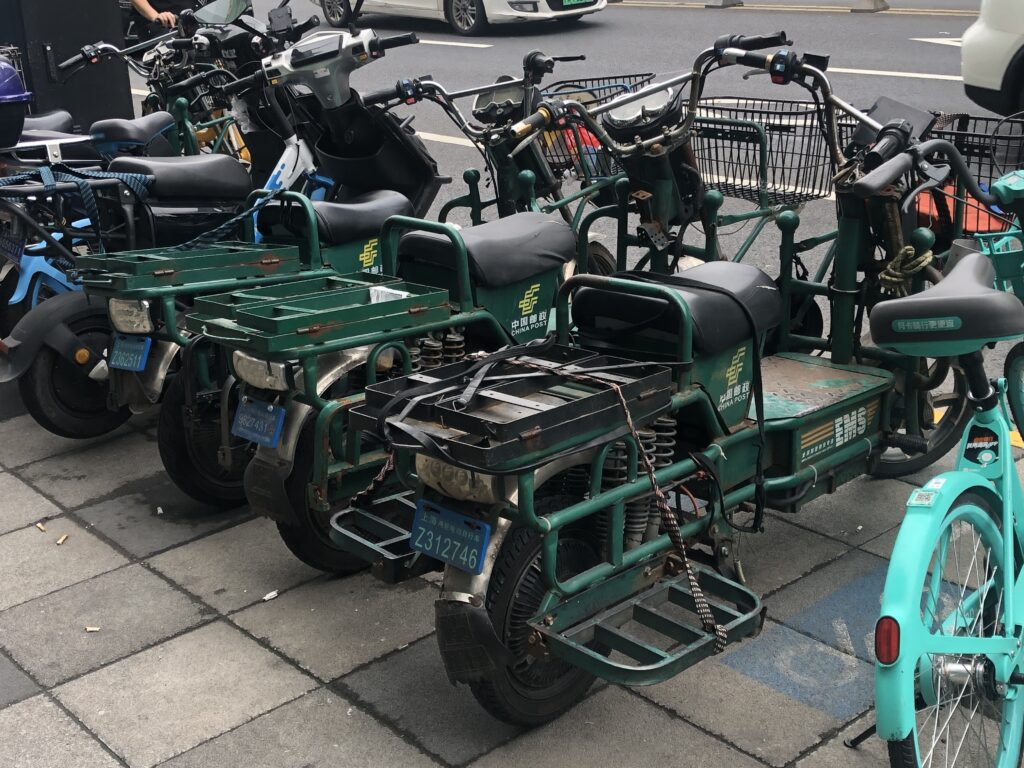Featuring: Postal vans, postal electric bicycles, EMS logistics and stamps.
As promised, a second go at Shanghai’s postal facilities the day after my first, this time the postal branch office (“支局”) on Tianshan Rd. Being a “branch” and not a “station,” it is visibly more spacious than its Zhongshan Rd. West counterpart, equipped, other than your regular postal and banking counters, or a similarly idle security guard, with two additional perks, if you could call them that. The first is a magazine stand exhibiting three lonely, likely un-perused copies of Qiushi (求是), the Chinese Communist Party’s flagship journal — they are provided for any post-office-goer’s entertainment for free, apparently, but I must refrain from commenting on their popularity. The second, probably a more welcome sight to many, is a sales counter that sells — wait for it — stamp collection sets and cigarettes, prominently exhibiting a notice on cig prices regulation or something of the like. I would have taken a picture of this wondrous juxtaposition, but the alert clerk behind it was a rather private person.


Cars, Cars, Cars
And, thanks to it being a “branch office,” the Tianshan Rd. facility also acts as a nexus of distributing mail. There is plenty of evidence to be found, not in, but outside the postal building. A dark green van, marked “China Post,” was parked by its doors waiting to load or unload packages — these postal vehicles also represent a particular arena where China’s determination to go “green” (and please do excuse the pun) can most evidently be witnessed: as early as May 2018, China Post promised to do three things, among many others, by 2020 — (1) to add only clean-energy postal vehicles to its urban fleet; (2) to use digital mailing orders for 90% of its packages; and (3) to popularize delivery by electric tricycles.
Only a few days after that promise was made, the city of Beijing received 147 electric vans to serve its six downtown districts, several sub-centers, embassy rows and airport areas. 147 sounds impressive, and it really is, if you are to line them head to tail, but when you compare that number with 20,825, which is the total number of postal vehicles in that city in 2022, it becomes evident that the total electrification of China Post’s legion would take some time indeed.
The same holds true for Shanghai — it has around 23,000 postal vehicles (a statistic on the decline, probably due to competition from private delivery companies), which have yet to be fully clean-energy-driven. Indeed, the one I saw on Tianshan Rd. almost certainly consumed gasoline. But still, the city is on its way to replace all downtown delivery vehicles with electric ones (probably by 2025), a policy in line with priorities set in 2023 by six national Ministries (counting the powerful Development and Reform Commission) to electrify 80% of all public service vehicles between 2023 and 2025. The municipal government of Shanghai is also determined to expand its electrification efforts to cover rural postal vehicles as well, but this ambitious plan does not seem to have a deadline.
Of course, some modes of postal transportation are by their very nature carbon-free and can save a lot of hassle. By that I meant electric bicycles, which are legion in China and cannot be missed. Postal e-bikes, as anything postal is to be expected, look cooler than their civilian peers (anyone with doubts should be referred to that tongue-twister of a Westcoaster mailster). Information about these is scarce, and I cannot be sure whether their makes and models are uniform across China (or even Shanghai, for that matter), but it would appear that the postal service’s heavy reliance on these little guys has caused some concern regarding their safety — improperly charged e-bikes, after all, are extremely prone to burning to a crisp. For that reason in March and June 2024, Harbin and Xinxiang (in Henan Province) each hosted training sessions to educate their post-men and -women to, well, be safe.

EMS, Express & Logistics — The Same Thing

Next door to the post office is something called China Postal Express and Logistics, which, upon some Googling — apologies, some Binging — turned out to be our good old EMS (Express Mail Service, an international service under the aegis of the Universal Postal Union, or UPU) dressed anew. Now a daughter company to China Post, its website boasts not only of that staple function, but also of supply chain solutions, warehousing, commodity transportation and financing. This does appear consistent with China Post’s general impression of being a jack of all trades — on the so-called “to C” side of things (i.e., to consumer, as opposed to “to B,” or to business) CPE&L also offers quick delivery of visas and driver’s licenses, as well as an “e-shop” of mostly agricultural products that, thanks to China Post’s intrinsic transportation advantages, can be shipped to their purchasers on quite short notice.
And… the Stamps

And naturally I also asked to see their stamps for sale, and discovered that the four “Beautiful China” stamps I got from Zhongshan Rd. West are but a few among many peers. Five additional members in that series were found here: Snow Town at Mudanjiang (牡丹江雪乡), ¥0.40; Red Beach at Panjin (盘锦红海滩), ¥1.20; Sandy Lake at Shizuishan (石嘴山沙湖), ¥2.00; Field Enclosure at Xinghua (兴化垛田), ¥3.00; and Xixi Wetlands of Hangzhou (杭州西溪湿地), ¥4.20. Sources indicate that this series now includes three collections, issued respectively in 2013, 2016 and 2021. They now number 16 in total, but more collections are underway, allegedly, until each and every provincial-level jurisdiction has a pleasant-looking location featured on one of these stamps.
